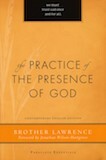Prayer Triggers
Blog / Produced by The High Calling
In December—smack in the middle of Advent—I was hurriedly sweeping my family room floor, frustrated I had to waste time sweeping when there were gifts to be purchased and wrapped, cookies to be decorated, parties to be planned. Suddenly, into my head popped Henri Nouwen’s words about Advent as a season of “active waiting,” which he says is the belief that this moment is the moment—God is doing something right here, right now, and we want to be present to it.
I looked at the fir needles and dust and tiny LEGO pieces I’d collected in a pile with my broom, and I realized I was not wasting time. In this moment, with my broom, God was at work, drawing my attention to Himself. He was helping me to pray.
In the months since, sweeping has become what I call a prayer trigger. A prayer trigger is anything that you see or do on a daily (or many times a day) basis that prompts you to pray.
Prayer Triggers
On my friend’s work desk is a small lacquer box. Inside the box are dozens of small laminated cards. On each card is a word: courage, loyalty, hope, beauty, joy, perseverance. Each morning, my friend takes out a card and props it against her computer monitor. Throughout the day, whenever she glimpses the word, she uses it as a call to prayer, either for herself or for someone who is on her mind. Because the word changes each day, she notices it more often than when the word is static day after day, and her prayers in response to the card change, too.
Another friend told me that every time she dries her hands, she holds the towel for an extra second and breathes a prayer. And still another said that every time he gets on an elevator, he prays for the people riding it with him.
All of these are prayer triggers, daily actions that my friends have turned into opportunities to remember God’s presence, to turn their faces intentionally back to His.
Some prayer triggers are temporary. During a recent church mission trip, one of our staff members who stayed home wanted to pray for her colleagues while they were away. To be in frequent prayer for them, she knew she would need frequent reminders to pray. Since she spends a lot of time out and about in the city, she decided that during the ten days of the mission trip, every time she saw a city bus she would pray for her colleagues and the people they were working with.
Other prayer triggers become habits. For years, I would pray the Jesus Prayer every time I went down my basement stairs (usually to do the laundry). About four years ago, I noticed that as I went down those stairs, the Jesus Prayer—“Lord Jesus Christ, Son of God, have mercy on me a sinner”—began to “pray itself in me.” I’d read those words in many, many books on prayer, and now I was experiencing it! Prayer had gone from a conscious choice to an unconscious reality—at least when I was on the basement stairs.
Practicing the Presence
Almost 400 years ago, Brother Lawrence wrote that he experienced the presence of God as much and as deeply in his kitchen among the monastery’s pots and pans as in the choir chanting the Psalms. Washing pots, chopping vegetables, browning meat—all became a call to prayer, a way to become aware of God’s presence with him, right where he was.
Brother Lawrence’s ability to live in constant communion with God is called “practicing the presence of God.” It’s not called practicing the presence of God for nothing. It’s a discipline, and like all disciplines, it’s something we have to practice.
By prompting us to pray—to turn our thoughts Godward, even for an instant—prayer triggers are one simple way to practice the presence of God in real time, in the lives we have. They enable us to begin to live as Brother Lawrence did, in continual communion with God.
Since that December day when God met me in the sweeping of my floor, my broom has become a prayer trigger, prompting me to give thanks for the mundane work of swishing straw bristles across oak boards, for the glorious fact that God is present and active, drawing me to himself, even as I draw the broom across the floor.





